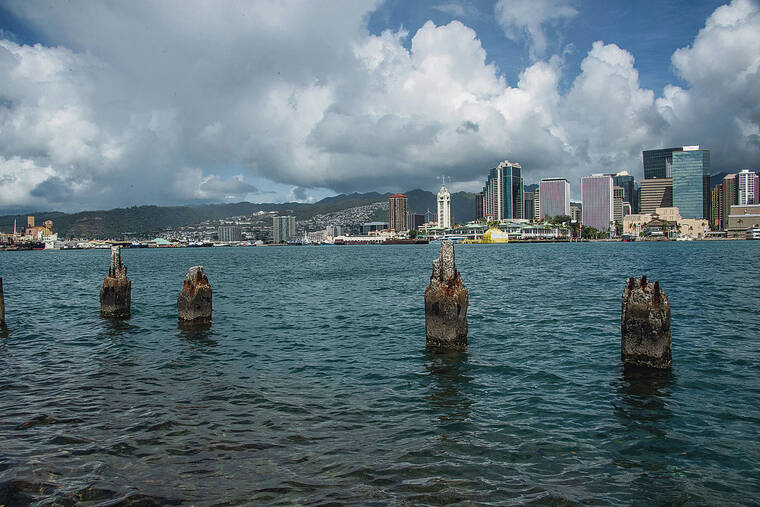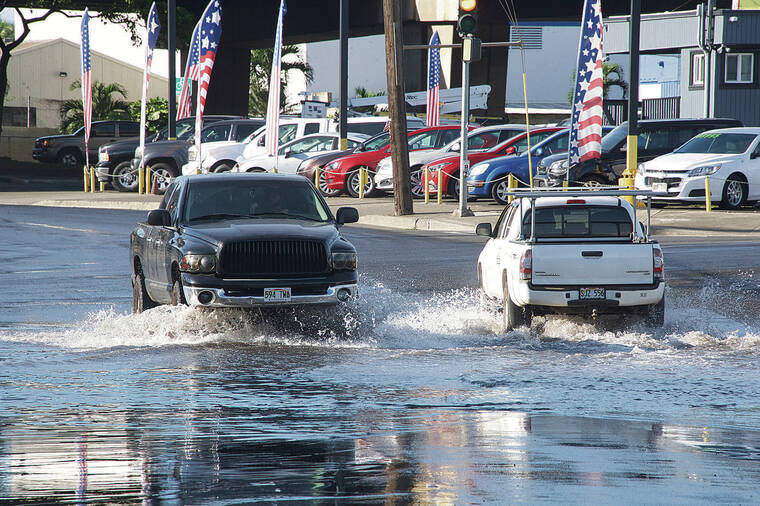By 2050, sea level in Hawaii could rise by as much as 1 foot

CRAIG T. KOJIMA / CKOJIMA@ STARADVERTISER.COM
At top, the view of downtown from Sand Island on Tuesday.

CRAIG T. KOJIMA / CKOJIMA@ STARADVERTISER.COM
Above, motorists dealt with salt water on Ahua Street in Mapunapuna during the king tides.


America’s coastline will see sea levels rise in the next 30 years by as much as they did in the entire 20th century, with major Eastern cities hit regularly with costly floods even on sunny days, a government report warns.
By 2050, seas lapping against the U.S. shore will be 10 to 12 inches higher, with parts of Louisiana and Texas projected to see waters 1-1/2 feet higher, according to a 111-page report issued Tuesday by the National Oceanic and Atmospheric Administration and six other federal agencies.
In Hawaii, sea levels are expected to be lower than the U.S. average by 2050, according to the report, but not by much.
“It confirms what we already know: that sea level rise is going to be significant and damaging,” said climate scientist Chip Fletcher, interim dean of the University of Hawaii School of Ocean and Earth Science and Technology.
“Make no mistake: Sea level rise is upon us,” said Nicole LeBoeuf, director of NOAA’s National Ocean Service.
The projected increase is especially alarming given that in the 20th century, seas along the Atlantic Coast rose at the fastest clip in 2,000 years.
Don't miss out on what's happening!
Stay in touch with breaking news, as it happens, conveniently in your email inbox. It's FREE!
LeBoeuf warned that the cost will be high, pointing out that much of the U.S. economy and 40% of the population are along the coast.
However, the worst of the long-term sea level rise from the melting of ice sheets in Antarctica and Greenland probably won’t kick in until after 2100, said ocean service oceanographer William Sweet, the report’s lead author.
Warmer water expands, and the melting ice sheets and glaciers add more water to the world’s oceans.
THE REPORT “is the equivalent of NOAA sending a red flag up” about accelerating the rise in sea levels, said University of Wisconsin-Madison geoscientist Andrea Dutton, a specialist in sea level rise who wasn’t part of the federal report. The coastal flooding the U.S. is seeing now “will get taken to a whole new level in just a couple of decades.”
“We can see this freight train coming from more than a mile away,” Dutton said in an email. “The question is whether we continue to let houses slide into the ocean.”
Sea level rises more in some places than others because of sinking land, currents and water from ice melt. The U.S. will get slightly more sea level rise than the global average. And the greatest rise in the U.S. will be on the Gulf and East coasts, while the West Coast and Hawaii will be hit less than average, Sweet said.
For example, between now and 2060, expect almost 25 inches of sea level rise in Galveston, Texas, and just under 2 feet in St. Petersburg, Fla., while only 9 inches in Seattle and 14 inches in Los Angeles, the report said.
While higher seas cause much more damage when storms such as hurricanes hit the coast, they are becoming a problem even on sunny days.
Cities such as Miami Beach, Fla.; Annapolis, Md.; and Norfolk, Va., already get a few minor “nuisance” floods a year during high tides, but those will be replaced by several “moderate” floods a year by midcentury, ones that cause property damage, the researchers said.
“It’s going to be areas that haven’t been flooding that are starting to flood,” Sweet said in an interview. “Many of our major metropolitan areas on the East Coast are going to be increasingly at risk.”
The western Gulf of Mexico coast should get hit the most with the highest sea level rise — 16 to 18 inches — by 2050, the report said. And that means more than 10 moderate property-damaging sunny-day floods and one “major” high-tide flood event a year.
The eastern Gulf of Mexico should expect 14 to 16 inches of sea level rise by 2050 and three moderate sunny-day floods a year. By midcentury the Southeast coast should get a foot to 14 inches of sea level rise and four sunny-day moderate floods a year, while the Northeast coast should get 10 inches to a foot of sea level rise and six moderate sunny-day floods a year.
AN OVERVIEW of the study prepared by NOAA says the Hawaiian Islands should expect 6 to 8 inches of sea level rise by midcentury. But the text of the report suggests the number could be higher.
Phil Thompson, director of the UH Sea Level Center and assistant professor of oceanography, said the report’s intermediate and low-intermediate scenarios for Hawaii suggest that the islands could see 10 to 12 inches of sea level rise by 2050.
“Even if there is less than average sea level rise here, that doesn’t equate to a lower amount of sea level rise impacts. Hawaii is vulnerable because of how it is developed very close to its coastlines,” he said.
Thompson said the islands are also vulnerable because of powerful waves, winter storms and other natural factors that compound the issue.
Thompson in 2021 published a NASA-funded study that found that Hawaii and other U.S. coastal regions will experience an accelerating number of high-tide flooding days for about 10 years starting in the mid-2030s, due to the twin effects of sea level rise and natural fluctuations in the tides.
Not only will many more coastal areas experience flooding at high tide; there will be times when the flooding comes in clusters that make for severe weeks or possibly months, according to the study.
Thompson said he will adjust the projections in his model using the data from the NOAA report, but it won’t affect the timing of the accelerating wave of high-tide flooding days.
He said high-tide flooding at Mapunapuna, for example, will jump from a handful of days a year now to 50 or 60 annually.
“It’s a problem and it’s not going away,” he said.
Sea level rise is only expected to get worse in the second half of this century. The NOAA report is projecting an average of about 2 feet of sea level rise in the United States — more in the East, less in the West — by the end of the century.
———
Star-Advertiser staff reporter Tim Hurley contributed to this story.



